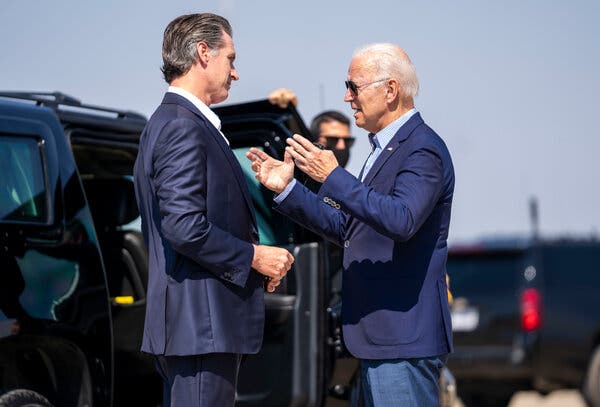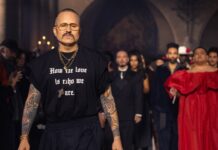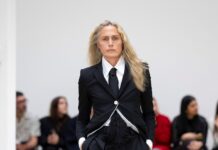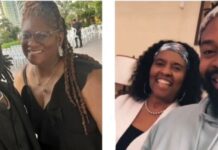
LONG BEACH, Calif. — In a final push to maintain Democratic leadership in California and fend off the recall of Gov. Gavin Newsom, President Biden encouraged voters at a rally in the state on Monday night to reject the Republican-led effort to push Mr. Newsom from office.
Mr. Biden’s visit, his first to California as president, came the day before the election on Tuesday. The president’s arrival underscored the alarm within the Democratic Party at the possibility of losing the governorship of the nation’s most populous state, where Democrats outnumber Republicans nearly two to one.
“You can either keep Gavin Newsom as your governor, or you’ll get Donald Trump,” warned Mr. Biden, who compared the leading Republican candidate, Larry Elder, to a clone of the former president. “It’s not a joke.”
At the rally Monday evening in Long Beach, Mr. Biden appeared with Mr. Newsom, who polls show is likely to prevail, after a nervous summer for Democrats in which polls showed the recall had a good shot of succeeding. But since those early projections, millions of dollars have flooded the state on Mr. Newsom’s behalf, campaign money the Democratic Party has used in get-out-the-vote efforts.
In Mr. Newsom, the president sees not just a member of his own party whose job is in jeopardy, but an ally on policy who has been pushing vaccine mandates and aggressive efforts to combat climate change, two issues that have defined the early days of Mr. Biden’s presidency.
On the pandemic, Mr. Newsom has positioned himself in opposition to Mr. Trump, repeatedly describing the recall as a matter of life and death rather than a question of his popularity. His top rival, Mr. Elder, a conservative talk radio host, has said that lifting mask rules and vaccine mandates would be his top priority if elected.
Mr. Newsom has focused voter attention on the state’s strict pandemic rules as the Delta variant has surged, filling hospitals in states led by Republicans who have imposed fewer restrictions.
The state was the first to mandate that all teachers in both public and private schools be vaccinated or else face regular testing, and the governor has toured the state and implored residents to get vaccinated. Seventy percent of Californians have received at least one shot, a higher rate than many other large states, including New York, Texas and Florida.
Mr. Biden told voters at the rally that the election’s outcome would have an impact far beyond California. “It’s going to reverberate around the country and, this is no joke, it’s going to reverberate around the world,” he said.
Mr. Newsom, who took the stage before the president, similarly framed the election as a contest between California’s proud progressivism and what the Democrats characterized as the divisive politics that Mr. Trump represented.
“We may have defeated Donald Trump, but we have not defeated Trumpism,” Mr. Newsom said.
Mr. Newsom has struggled to connect with the state’s growing core of young and Latino voters, many of whom have said that they do not find the governor particularly compelling and that they are weary of partisan tribalism. On Monday, the choice to host a rally with the president at Long Beach City College, where 53 percent of the student body is Hispanic, appeared to be an attempt to dispel the notion that he has failed to engage Latino voters.
“We’re in Long Beach, one of the most diverse cities in the most diverse county, Los Angeles County, in one of the most diverse states in the most diverse democracy in the world,” Mr. Newsom said on Monday night.
The president and the governor appeared alongside Long Beach’s mayor, Robert Garcia, who is the first Latino and openly gay man to lead the diverse city of almost half a million people just south of Los Angeles, and was one of the speakers who introduced the president. Before the rally began, a smattering of supporters of Mr. Trump gathered near campus waving signs that read “unvaxxed lives matter” and “Trump won,” drawing chants of “Biden won!” from those heading to see the president.
Among those in the crowd was Daniel J. St. Jean, a student who turned 18 in the months since the presidential election last year. Supporting Mr. Newsom in the recall was the first time he had voted in his life. “I like that he speaks his mind, that he’s cool, calm and levelheaded,” Mr. St Jean said.
Mr. Biden, who before traveling to Long Beach visited Northern California to tour areas devastated by wildfires and promote his climate agenda, arrived in a state where he won the presidential election last year by a wide margin, and where the fear of four more years of Mr. Trump drove large numbers of Californians to the polls. Mr. Biden’s approval in the state has dropped slightly, according to a recent Public Policy Institute of California poll, but is still high: About six in 10 Californians approve of his performance as president.
The campaign stop for Mr. Newsom was the president’s second in-person campaign event since taking office and one of only a handful of political events he has participated in. In July, he made a fiery campaign appearance with former Gov. Terry McAuliffe of Virginia, who is running this year for his old office.
Mr. Biden’s first fund-raiser as president was a virtual event in March for Keisha Lance Bottoms, the mayor of Atlanta, who was an early and stalwart supporter of his 2020 presidential campaign. Last month, he participated virtually in a fund-raiser for the Democratic National Committee.
When asked why the Biden administration believed it was important for the president to campaign for Mr. Newsom in California, Jen Psaki, the White House press secretary, deadpanned, “Because the election is Tuesday.”
She added: “The president remains quite popular in California, as he does in Virginia and other states where there are competitive elections this year. And certainly we don’t go campaign in states where we aren’t wanted, but hopefully this will be helpful to the efforts of the governor.”

SAN BERNARDINO, Calif. — The handful of volunteers gathered on Monday in the small office of the Coalition for Humane Immigrant Rights, one of Southern California’s largest Latino and immigrant rights organizations.
Karen Diaz, a lead organizer, reminded them just how important the recall election would be. Without Gov. Gavin Newsom, she warned, undocumented immigrants could lose their rights to health care services and driver’s licenses. Latino essential workers, who have died from Covid-19 and have been sickened by the coronavirus at disproportionately high rates, would lose what protections they do have. And money set aside to help renters and public school students would soon evaporate.
Latinos have been some of the most ambivalent voters in the weeks leading up to the recall, turning in ballots at a lower rate than Black, Asian and white voters. While Mr. Newsom’s standing with Latino voters has improved in recent polls, some see grim warnings for Democrats and have urged the party to do more to reach out to them.
“This is a fight for us,” Ms. Diaz reminded the volunteers just before they took off in blazing 99-degree heat to knock on doors of Latino voters who had yet to cast a ballot.
Ms. Diaz and Ma Carmen Rodriguez headed to a cul-de-sac in San Bernardino, a working-class city about 60 miles east of Los Angeles. They knocked on nearly a dozen doors before their first success: Lina Luna, an 18-year-old who would be a first-time voter.
Ms. Luna said that though she had yet to turn in her ballot, she planned to support Mr. Newsom and to vote against the recall on Tuesday. But she seemed confused about just how to do so.
“I can’t mail it in anymore?” Ms. Luna asked.
“Well, you can, but it’s better to turn it in person, because then it gets counted right away,” Ms. Diaz replied, showing her the nearest location where she could drop off the ballot. “You don’t even have to wait in line,” she added. “But go early. Don’t forget and wait until the evening and the polls close, then it’s too late.”
Ms. Luna assured them she would take their advice.

ROWLAND HEIGHTS, Calif. — Election Day is more like election month in California, since registered voters across the state received their ballots by mail weeks ago and more than a third have already sent them back. But Elliot Chang was not one of them.
Instead, Mr. Chang waited until Monday morning to drop off his ballot at John A. Rowland High School in Rowland Heights, a heavily Asian American suburb east of Los Angeles. The polling site, like hundreds of others around the state, was open for early in-person voting.
“There’s something about casting your vote live that I don’t want to give up,” said Mr. Chang, 56, who wore an “I voted” sticker on his button-down shirt. Mr. Chang is not registered with either party, a trait he shares with roughly a third of voters in California’s 39th Congressional District, southeast of Los Angeles.
And while he said there was plenty about Gov. Gavin Newsom he did not like, he never considered voting him out of office.
“The alternatives were not appealing,” Mr. Chang said, adding that he thought Mr. Newsom had done a good job managing the pandemic — the most important issue determining his support.
“I want there to be someone in charge who believes in vaccines, who believes in masks,” he said.
Mr. Chang’s viewpoints were the type of support Mr. Newsom has counted on throughout the recall campaign. In the closing days of the election, with residents concerned about the Delta variant as children return to schools, Mr. Newsom and his supporters sought to portray the choice as a matter of life and death.

Californians have been voting early for weeks in the election to recall Gov. Gavin Newsom.
But it is unclear how long it will take to get a definitive answer on whether he will keep his job.
Depending on the number of early ballots and the amount of in-person voting on Tuesday, the math could be clear within a few hours of when the polls close at 8 p.m. Pacific time, election experts say. But if the race is tighter than expected, weeks could pass while the counting drags on.
Recall attempts are a fact of political life for governors of California. But they do not usually make it onto the ballot, and Californians have gone to the polls only one other time to determine whether the state’s top officeholder should be ousted. That was in 2003, when Gov. Gray Davis was recalled and replaced by Arnold Schwarzenegger. Since then, the state’s voting rules and electorate have changed substantially.
Because of the safety concerns arising from the coronavirus pandemic, ballots were mailed early to all of the state’s 22 million or so registered and active voters in the 2020 election. Voters can return their completed ballots by mail, deposit them in secure drop boxes, vote early in person or vote at a polling place on Tuesday.
Nearly 40 percent of registered voters have already cast ballots, but many Republicans have indicated that they plan to vote in person, citing — without evidence — a concern that election officials in the Democrat-dominated state will tamper with their ballots. Studies after the 2020 election found that the system had worked smoothly, with no systemic voter fraud.
Early Democratic ballots have outnumbered Republican ones by two to one, with overwhelming majorities of voters in both parties telling pollsters they plan to vote along party lines. Mr. Newsom is a Democrat, as is about 46 percent of the electorate.
But that margin is expected to tighten as Republican voters — who represent fewer than a quarter of registered voters — head to the polls.
Vote counts are notoriously slow in California because the state is so massive. The law for this election allows county officials to open and process early ballots as they come in, but those results cannot be shared with the public until the polls close, said Jenna Dresner, a spokeswoman for the California secretary of state’s office.
California has 58 counties, and each processes its ballots differently. Results often land later in larger counties, such as Los Angeles County. Officials have 30 days to complete their official canvass and must give vote-by-mail ballots postmarked on Election Day a week to arrive. The certified count is not expected until Oct. 22.
Significant partial counts should be available within a couple of hours after polls close in some key areas, such as the Bay Area and Orange County. And the electoral math in California should offer some strong clues about the outcome, said Paul Mitchell, a vice president of Political Data Inc., a nonpartisan supplier of election data.
Because so many voters are Democrats, he said, the higher the turnout, the better Mr. Newsom’s chances are of beating the recall. If the overall turnout hits 60 percent, he said, the proposed ouster of Mr. Newsom is almost mathematically impossible.

The high-profile election that thrust Arnold Schwarzenegger into power in 2003 was the first time that many Americans heard of a recall.
The idea that California voters could remove their governor from office before the end of his term — and replace him with a movie star — was unfamiliar, if not unbelievable.
But recalls have a long, storied history in the United States.
In 1776, after declaring independence from the British, some of the original 13 colonies wrote recall provisions into their state constitutions as a way to guard against the power of elected officials, said Joshua Spivak, a senior fellow at Wagner College’s Hugh L. Carey Institute for Government Reform. But the idea of the recall did not make it into the U.S. Constitution, and instead went into hibernation for more than a century.
“It took a Philadelphia-born doctor in Los Angeles to truly revive the recall,” Spivak writes in his book, “Recall Elections: From Alexander Hamilton to Gavin Newsom.”
In 1898, a Los Angeles physician named John Randolph Haynes proposed adding a recall measure to the city’s charter as a way of rooting out corruption. Five years later, the city became one of the first places in the nation to adopt the recall.
In the seven years that followed, 25 other California cities passed similar measures, according to Mr. Spivak.
And in 1911, California voters overwhelmingly approved a ballot measure that made the state the third to allow recalls. Now, 110 years later, most states allow local officials to be recalled; 19, including California, allow the removal of state officials as well.

More than 35 percent of California’s active, registered voters have already cast their ballots, and early voting is underway in several counties. If you missed the deadline to register to vote in the recall election, don’t worry. You can still register on Tuesday.
Our Voter Guide has everything you need to know about where to vote, how to turn in your ballot and when we can expect to know the results.
Where is my ballot?
All registered and active California voters should have received a ballot by mail in the past few weeks. You can mail that ballot back or return it to a secure drop box by 8 p.m. You can track when your vote-by-mail ballot was mailed, received and counted at https://california.ballottrax.net/voter/.
Where can I vote in person?
Voters can cast ballots in person (you can find early voting locations here.) until 8 p.m. Pacific when polls close.
You can check whether you’re registered to vote here. Visit the Secretary of State’s website to learn more about same-day voter registration.
When will we know the results?
So when will we know the results? After Election Day, county election officials have to complete their work receiving and counting ballots, although we may have some idea of the vote by then, since nearly eight million ballots have already been returned and many more are expected to come in as we get closer. Counties can process early ballots and get them ready to count, but they cannot start tallying until the polls close.

After the polls overestimated Democratic candidates in 2016 and 2020, it is reasonable to wonder whether Gov. Gavin Newsom’s lead in the California recall election might prove as illusory as Hillary Clinton’s lead in Wisconsin or Joe Biden’s in Florida.
It’s not impossible. But Mr. Newsom’s lead now dwarfs the typical polling error and is large enough to withstand nearly every statewide polling miss in recent memory.
Opposition to recalling Mr. Newsom leads by 17 points, 58 to 41 percent, according to the FiveThirtyEight average. Polls in 2020 overestimated the Democrats by an average of about five percentage points.
There was no state in either the 2016 or 2020 presidential elections where the final polls missed by 17 percentage points. Perhaps the worst recent polling miss — Senator Susan Collins’s comfortable nine-point victory after trailing in the polls by three points — is in the ballpark, but would still fall five points short of erasing Mr. Newsom’s lead.
Many of the most embarrassing and high-profile misses for pollsters, such as the seven-point polling errors in Wisconsin in 2016 and 2020, might still leave Mr. Newsom with a double-digit victory.
It is hard to find many precedents for such a large polling error. According to Harry Enten, a writer at CNN, there are only four cases in the last 20 years where the polling average in a race for governor was off by at least 15 percentage points.
Mr. Newsom’s opponents can hope that the idiosyncrasies of a recall election might make it more challenging for pollsters than a typical general election. Special and primary elections often have larger polling errors.
But the polls were fairly accurate in the last California gubernatorial recall and dead-on in the high-profile effort to recall former Gov. Scott Walker of Wisconsin in 2012. The high turnout in early voting in California so far tends to reduce the risk that an unusual turnout would contribute to a particularly large polling error.
And California is not a state where the polls have missed badly in recent election cycles. The largest polling errors have been in Wisconsin, Maine and other states with large numbers of white working-class voters. That’s not California. Just 22 percent of California voters in 2020 were whites without a four-year college degree, the second lowest of any state, according to census data.
Perhaps as a result, statewide polling in California has generally been fairly accurate.
Joe Biden led the final California polls by 29.2 points, according to FiveThirtyEight.
He won by 29.2 points.
Clockwise from top left: Kevin Faulconer, John Cox, Kevin Kiley, Caitlyn Jenner and Larry Elder.
Dozens of Republicans are running to replace Gov. Gavin Newsom of California. But only a handful of them have registered any meaningful support in the polls or raised the kind of money needed to run a statewide campaign.
They include political veterans like Kevin Faulconer, the former mayor of San Diego, and Kevin Kiley, a member of the State Assembly from Rocklin. There are business leaders, including John Cox, who has run for office several times before, and first-time candidates, including Larry Elder, a talk radio personality, and Caitlyn Jenner, the former Olympian.
Their vast differences reflect the disjointed nature of California’s Republican Party — an institution that has been hollowed out over the years and is now so small that it is practically a third party.
Here is the complete list of challengers from the California secretary of state’s office.
Only twice in U.S. history has a governor been recalled.
You probably know about the second: In 2003, Gov. Gray Davis of California was replaced by Arnold Schwarzenegger. But you might not know about the first, which happened 100 years ago, on Oct. 28, 1921.
Gov. Lynn Frazier of North Dakota narrowly lost that recall election to Ragnvald Nestos, 107,332 votes to 111,434, just two years after signing the amendment in the State Constitution that made recalls possible.
The immediate catalyst was a conflict over a state-run bank and a state-run mill. The larger issue was an ideological divide between two factions of the Republican Party: the progressive and socialist Nonpartisan League, to which Mr. Frazier belonged, and the conservative and capitalist Independent Voters’ Association, to which Mr. Nestos belonged.
North Dakota was going through a rough time: “Farm prices were down, crops were poor because of weather, and the state was left in an economic depression following World War I,” according to the State Historical Society of North Dakota. It was in that context that Nonpartisan League candidates had been elected, pledging to create a state-owned bank and state-owned mills, elevators and packing plants.
The Frazier administration managed to push through several progressive priorities, including women’s suffrage, an income tax system with higher rates for higher earners, an inheritance tax and the very recall mechanism that would be used against it. But, while it created the Bank of North Dakota and a state homebuilders’ association and began building a $2 million mill, its state ownership platform went south quickly.
The recall campaign — which targeted Mr. Frazier; the North Dakota attorney general, William Lemke; and the state agriculture commissioner, John Hagan — was bitter from start to finish.
In a statement quoted in The New York Times, the secretary of the Independent Voters’ Association said the stakes were no less than “whether or not public officials shall be required to render honest public service and not be permitted to appropriate public property for their personal gain.”
On the other side, the editor of The Fargo Daily Courier-News, a newspaper aligned with the Nonpartisan League, wrote on Oct. 3 that the Independent Voters’ Association was “counting on whipping their halfhearted supporters into line, through the use of the big campaign funds they expect to get from the railroads, the grain trade and the big bankers.”
Mr. Lemke survived the vote, but Mr. Frazier and Mr. Hagan were removed from office.
It was not the end of Mr. Frazier’s political career, though. He was elected to the U.S. Senate just a year after being recalled from the governorship, and served in Washington for 18 years.

The recall election of California’s governor has been unusual for a lot of reasons. But one of the first things that set it apart was that just a month before Election Day — even as ballots began to hit mailboxes — many Californians didn’t even know a vote was taking place.
That was especially true in predominantly Latino communities, where advocates worried that voters would be too preoccupied by work and family to learn about what was at stake. Young people and immigrants may be voting for the first time, and the ballot is confusingly different from other elections; there is no runoff.
Covid-19 has continued to ravage those communities, where many essential workers are struggling to recover from the worst of the pandemic and its economic fallout. “We’re asking people to vote by Sept. 14, and they might get evicted by Sept. 30,” said Christian Arana, vice president of policy for the Latino Community Foundation.
Now, though, after millions of text messages have implored voters to cast their ballots, and recognizable Democrats like Senator Bernie Sanders of Vermont and former President Barack Obama have appeared on television screens, Gov. Gavin Newsom is hoping that voters will be motivated to turn out.
With one day of voting left, more than twice as many Democrats have returned their ballots as Republicans, according to Political Data, Inc., an election data supplier.
But some signs suggest that Mr. Newsom’s message might not have reached some of the voters most important to California’s political future. There are more registered 18- to 34-year-old voters than any other age group, but just 20 percent of them have cast ballots, compared with 57 percent of voters 65 and older.
And just 23 percent of Latino voters have returned their ballots, compared with 42 percent of white voters. Some may vote in person this week. But many young and Latino voters have said they’re ambivalent about Mr. Newsom and about a Democratic Party that has long relied on their support.

Forty-six candidates are running to replace Gov. Gavin Newsom if California voters recall him on Tuesday. In what order should their names appear on the ballot?
It may sound like a frivolous question, but it isn’t: Research suggests that the order in which candidates are listed can affect who wins. Because of that, it is considered a best practice in election administration to randomize the order of names rather than list them alphabetically, to avoid disadvantaging candidates whose names begin with letters late in the alphabet.
Methods vary from state to state and sometimes from county to county. In Minnesota, major-party candidates “are listed in reverse order of their average vote in the last election,” minor-party candidates are subject to a random drawing, and nonpartisan candidates are subject to a formula enshrined in state law, according to the Minnesota secretary of state’s office. In South Carolina, candidates are listed according to their party, and the party order is rotated every two years. In Whatcom County, Wash., candidates are listed on primary ballots by random draw, and on general election ballots by the vote share they received in the primary.
And then there is California, which doesn’t randomize candidate names — it randomizes the entire alphabet.
As decreed by a drawing conducted 82 days before the election, the alphabet on Tuesday’s ballot will be X-K-T-V-F-N-R-G-J-Y-Z-L-M-B-A-Q-H-D-I-E-P-C-W-S-O-U. Candidates’ names will be alphabetized according to that drawing.
That means Caitlyn Jenner will appear before Larry Elder (J before E), and Sam Gallucci will appear before Ted Gaines (L before I).
But wait! There’s more. The names will appear in that order in California’s First Assembly District — but in the Second Assembly District, “the candidate who appeared first in Assembly District 1 drops to the bottom and the other candidates move up one position and so on throughout the 80 districts,” according to the California secretary of state’s office.
That means, depending on where in California you live, the names on your ballot might start at, say, B — like on the sample ballot pictured above — and wrap back around according to the alphabet drawing, ending at M.
It’s as easy as XKT.

As of Friday evening, the last day of California’s 2021 legislative session, there were 298 bills sitting on the desk of Gov. Gavin Newsom. They would do things like allow duplexes in single-family-house neighborhoods, expand access to police misconduct records and prohibit companies from using nondisclosure agreements to prevent employees from speaking out on discrimination.
Whether it’s because Mr. Newsom is too busy campaigning or he doesn’t want to touch anything controversial, it is a near-certainty that hundreds of bills will remain unsigned until after Election Day.
So: What happens if he’s recalled? The answer, in short, is he can still sign the bills if he wants. Depending on how close Tuesday’s vote is, it could take several days or longer for a winner to be declared. Beyond that, it will take several weeks for California’s Secretary of State to certify the election.
Were Mr. Newsom to be recalled, he would remain governor until after the election is certified, at which point the new governor would take the oath of office and assume his duties until January 2023.
There is precedent here. After being recalled on Oct. 7, 2003, and conceding the election, then-Gov. Gray Davis went on to sign several pieces of legislation before his last day in office on Nov. 17.

Farmers are a key constituency in California, where the $50 billion agricultural sector makes up about 3 percent of the state’s gross domestic product. During this year of exceptional drought, they are feeling the pinch of water restrictions, prompting many to support the recall of Gov. Gavin Newsom on Tuesday and choose a successor who they feel supports small businesses and will fight hard for their water needs.
In interviews in recent days, several farmers said Mr. Newsom hadn’t responded as urgently as they would like to their pleas for more water storage, such as dams, reservoirs or water banks, as a way of helping them through this drought and future ones.
“He’s not there for the state of California,” Mr. Gordon said of the governor. “We’re angry, and the people of the state want this guy gone.”
Mr. Gordon, the owner of several dairy farms near Los Angeles, is a lifelong Democrat who voted for Mr. Newsom, a Democrat, in 2018. But lately, he said, high taxes on milk, coronavirus shutdowns that have cut into his sales and state-imposed limitations on water for agriculture have made him so angry at the governor that he has paid for seven billboards throughout the state — most of them in the Central Valley, which produces a quarter of the nation’s food — urging people to remove the governor.
Mr. Gordon said he has spent about $44,000 for the billboards. “If I had to spend my last dime to get rid of this guy, I would,” he said. School closings during the pandemic have inflicted losses in milk sales of roughly $15,000 a day, he said. Between that financial blow and his taxes, he said, he’ll have to sell his cows and close the business by next year.
Some farmers expressed sympathy for Mr. Newsom. “He’s the governor at a very difficult time, and I believe he’s done the best job that he’s been able to do,” said Don Cameron, the general manager of Terranova Ranch, about 30 miles southwest of Fresno, and a supporter of the governor’s in the recall election. “There are a lot of farmers who don’t agree with that position, but it’s down political lines, unfortunately.”

The common wisdom in politics is that elections favor the incumbent. The candidate already in office has more name recognition, and can often raise more money than the challengers.
But that’s not the way recall elections have played out in recent years in the United States.
Between 2011 and 2020, there were about 1,000 recall elections of state and local officials held nationwide, with a removal rate of 60 percent, said Joshua Spivak, a senior fellow at Wagner College’s Hugh L. Carey Institute for Government Reform. And in California, the numbers are even less favorable for the incumbent. During that same time frame, there were 110 recall elections in the state, with a 78 percent removal rate, Mr. Spivak said.
In general, recalls work against the sitting official because the people most motivated to vote in the recall election are those interested in ousting them, experts say.
Gov. Gavin Newsom’s success, for example, hinges on whether enough Democrats will vote to counteract enthusiasm among Republicans.
But it’s unclear why California recalls are particularly difficult for incumbents to survive.
There may be an element of chance at play, Mr. Spivak said. Or it could be that Californians are more familiar with the concept of recalls, and therefore more likely to vote to remove someone, he said.
California was one of the first states to legalize recalls, and is the only place where a recall of a governor has made the ballot twice. This year alone, dozens of recall efforts against state and local officials are underway.
“I’m not sure that it’s anything more than that they just got these recalls on the ballot, and they’re pretty comfortable using the recall,” Mr. Spivak said.

The Sunset Strip in Los Angeles awoke on Monday to a hijacked billboard whose ad for the Netflix series “Lucifer” had been covered with one for Larry Elder, the conservative radio host and lead challenger in the campaign to recall Gov. Gavin Newsom.
The sign, outside the Viper Room nightclub, had “Gov. Elder” in the space where the act for the evening would be, and the billboard had been covered with sheets on which Mr. Elder’s surname had been painted in large block letters with an image of California.
“We have the strip to save,” the billboard said, a takeoff on Mr. Elder’s campaign tagline, “We have a state to save.”
The guerrilla street artist Sabo, a supporter of Mr. Elder, took credit for the installation, one of several posters and art pieces he has contributed to the campaign.
In a text message, he said he had chosen the billboard because the chairman of Netflix, Reed Hastings, had contributed $3 million against the recall, and because of the impact of the governor’s coronavirus restrictions on the local economy.
A half-dozen friends had helped, he said. “The Viper Room was closed all weekend,” he wrote. “The shutdowns have hurt them and the staff, along with most of the businesses on the strip.”
But, Sabo added, “I did this hit in the name of PUNK ROCK.”
By 8 a.m. Pacific time, the installation had been removed, and the Netflix advertisement was restored. “That was the fastest I’ve had a billboard taken down,” Sabo texted.

There’s a long-running cliché that politics in the San Francisco Bay Area is like a knife fight in a phone booth. But for anyone who can make it through the Bay Area’s political gauntlet there is a prize on the other side: a distinct advantage in statewide politics.
It starts with a simple fact: People in the Bay Area vote. They vote in presidential years. They vote in off years. They are such reliable voters, with such consistently high turnout rates, that Bay Area politicians — Vice President Kamala Harris, Governor Gavin Newsom and Senator Dianne Feinstein, all Democrats — have long dominated state politics. Senator Alex Padilla, Democrat of Los Angeles, is the first Senator from Southern California in nearly 30 years — and he was appointed by Mr. Newsom to serve out Ms. Harris’s term.
What makes the Bay Area’s advantage even more stark is that Los Angeles County, the state’s most populous with about 10 million people, has relatively poor turnout rates. Los Angeles County has over a million more registered voters than the Bay Area, yet the Bay Area regularly casts close to the same number of votes, according to an analysis by the Center for Inclusive Democracy at the University of Southern California. In some off-year elections the Bay Area actually casts more votes than L.A. County.
“It’s long been seen that if you are from the Bay Area you have a political advantage,” said Mindy Romero, director of the Center for Inclusive Democracy.
What makes the Bay Area vote so much? Partly it’s a demographic advantage: Bay Area residents are on average wealthier and better educated. The region also has a passionate political culture that has long been in the regular habit of voting. This ends up being a boon for Bay Area candidates because they not only have a wealthy base of donors to draw on — they don’t have to spend as much of the money they raise on local campaigning. Instead, they can focus their time, advertising and organizing muscle outside their home region.
“There’s a sense of pride that the Bay Area has long been home to so many of the state and country’s high profile politicians and their desire to defend their progressive leadership is real,” said Nicole Derse, principal of 50+1 Strategies, a political consulting firm in San Francisco.
Over the past week Governor Gavin Newsom has crisscrossed Southern California trying to drum up turnout. He hasn’t spent much time near his home base, because he knows the Bay Area will turn out.








